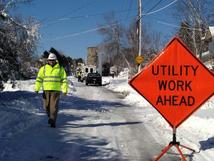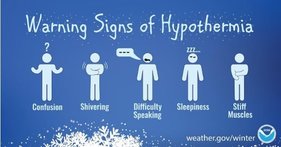
|
 Prepare to stay warm if the power goes out in your
winter wonderland.
The freezing rain, ice, and snow of winter storms
topple trees and knock down power lines.
Be ready with these power outage preparedness tips from The Ready Campaign:
- Build or restock your emergency
preparedness kit. Include a flashlight, batteries, water, food,
prescription medication, cash, first aid supplies, and extra clothing, blankets
or sleeping bags to stay warm.
- Have alternative charging methods for
your phone or any device that requires power. For more information, visit Get Tech Ready.
- If you rely on anything that is
battery-operated or power dependent like a medical device, determine a backup
plan. For more planning tips, visit Seniors and Individuals with Disabilities and Others with Access
and Functional Needs.
- Locate the manual release lever of your
electric garage door opener and know how to operate it.
- Keep your car’s gas tank full. Gas
stations rely on electricity to power their pumps.
- If you use your car to re-charge
devices, do NOT keep the car running in a garage, partially enclosed space, or
close to your home. This can lead to carbon monoxide poisoning.
- Close off unused rooms to consolidate
and retain heat.
- The power may be out for a prolonged
period. Plan to go to another location (the home of a relative or friend, or a
public facility) that has heat.
- Only use generators outside, away from
your home and NEVER run a generator inside a home or garage or connect it to
your home’s electrical system. For more information, visit the Generator Safety page of
the Department of Energy.
Visit Ready.gov for more tips on how to prepare for a Winter Power Outage.
|
 It does not have to be freezing for
hypothermia to set in.
According to the Centers for Disease Control (CDC), hypothermia can occur at temperatures above 40°F. Rain,
sweat, or submersion in cold water can cause it.
Know the warning signs and what to do if you suspect
you or someone you know may be suffering from hypothermia .
Warnings
Signs of Hypothermia
Adults:
- Body temperature
below 95 degrees
- Uncontrollable
shivering
- Exhaustion
- Confusion,
fumbling hands
- Memory loss,
disorientation
- Incoherence,
slurred speech
- Drowsiness
Infants:
- Bright red, cold
skin
- Very low energy
If someone is suffering from hypothermia, get
medical attention immediately and begin warming the person until help arrives.
Find several ways to warm a person on the CDC’s Hypothermia page.
If you must go outside, prevent hypothermia
by:
- Wearing several
layers of loose-fitting, lightweight, warm clothing rather than one layer of
heavy clothing. The outer garments should be tightly woven and water repellent.
- Wear mittens,
which are warmer than gloves.
- Cover all of your
body. Wear a hat and a scarf, covering your mouth to protect your face and to
help prevent loss of body heat.
For more information on how to prepare for the winter, visit
the Prepareathon Winter Storm section.
|
 Prepare
your business with the new toolkits and videos from Ready
Business.
Organizations
and their staff face a variety of hazards. The Ready Business program helps
organizations plan for these hazards.
The
Ready Business Toolkit series includes hazard-specific versions. The following
versions include step-by-step guides in English and Spanish to build
preparedness within an organization.
- Earthquake
“QuakeSmart” Toolkit
- Hurricane Toolkit
- Inland Flooding
Toolkit
- Power Outage
Toolkit
- Severe
Wind/Tornado Toolkit
The
Ready Business videos, available in English and Spanish, briefly explain several
key parts of getting ready, such as:
- Staff/Employee
Management;
- Physical
Surroundings;
- Physical Space;
- Building
Construction;
- Systems; and
- Community Service.
Download
and view these new resources at www.ready.gov/business.
|
Learn
how to prepare for extreme cold or a winter storm during a webinar on January
24 at 2:00 p.m. ET.
The
Federal Emergency Management Agency’s Individual and Community Preparedness
Division is holding a winter weather preparedness webinar. Webinar speakers will outline effective
preparedness practices and programs for organizations to prepare for extreme
cold and winter storms. The webinar will also offer safety tips for communities and families.
Plus, the webinar will have a resource sharing session to access various winter
weather preparedness materials available for download.
Title: Winter Preparedness
Promising Practices: Tools and Resources for Organizations and Families
Date: Wednesday, January 24,
2018
Time: 2:00 – 3:00 p.m. (ET)
This webinar will feature presenters from the following organizations:
- National Weather Service, National Oceanic and Atmospheric
Administration (NOAA)
- Georgia Power
- Burleigh County Snowmobile Community Emergency Response Team
(CERT), North Dakota
- Scituate Alliance for Natural Disaster Services (SANDS)
- Individual and Community Preparedness Division, FEMA
How to Join the Webinar:
We hope that you will be able to join us on January 24!
Disclaimer: The reader recognizes
that the federal government provides links and informational data on various
disaster preparedness resources and events and does not endorse any non-federal
events, entities, organizations, services, or products. Please let us know
about other events and services for individual and community preparedness that
could be included in future newsletters by contacting citizencorps@fema.dhs.gov.
|

|